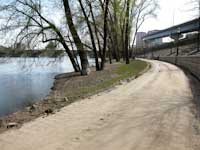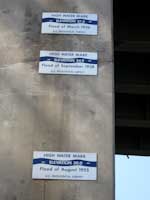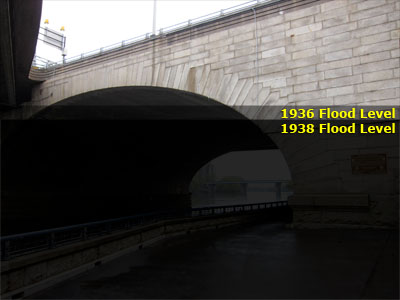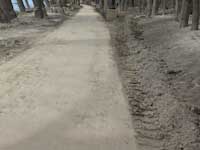Connecticut River - Flood Plain EarthCache
Connecticut River - Flood Plain
-
Difficulty:
-

-
Terrain:
-

Size:  (not chosen)
(not chosen)
Please note Use of geocaching.com services is subject to the terms and conditions
in our disclaimer.
This EarthCache brings you to the banks of the Connecticut River in
Hartford, an area that has seen significant flooding in years
past.
Flooding occurs when water in the river rises above its banks and
overflows onto land that is normally dry. Floods along the
Connecticut River are of the "Riverine" type and are typically
caused by runoff from snow melt in northern New England, heavy
rains from hurricanes or tropical depressions and periods of
sustained rainfall from storms passing through the area.
Activity 1

 The posted coordinates bring you to the parking area
at Riverside Park. Follow the wheelchair accessible trail south
along the river for about .4 miles to N41º 46.146 W72º 40.050,
where you will see a plaque detailing Connecticut River Flood Facts
as well as a high water mark sign showing the height of the river
at different flood stages. Read the plaque and gather information
about the worst floods to hit the Hartford area. Imagine the
awesome force of the river as it flowed through the area.
The posted coordinates bring you to the parking area
at Riverside Park. Follow the wheelchair accessible trail south
along the river for about .4 miles to N41º 46.146 W72º 40.050,
where you will see a plaque detailing Connecticut River Flood Facts
as well as a high water mark sign showing the height of the river
at different flood stages. Read the plaque and gather information
about the worst floods to hit the Hartford area. Imagine the
awesome force of the river as it flowed through the area.
In Hartford, normal river elevation is 3.8 above mean sea level
(AMSL). Water levels over 16 feet AMSL are considered flood stage.
A typical spring flood crests at 20.3 feet elevation AMSL.
Major Floods along the Connecticut
River
In more than 300 years of record keeping, the flood stage of the
river has crested higher than 30 feet only 4 times. Once in 1936,
1938 and 1955. You will learn about the additional year at the
cache site.
On March 21, 1936, the river crested in Hartford at an elevation of
37.0 feet AMSL. During the preceding 9 days, 14 inches of rain fell
across the river valley and combined with nearly 30 inches of
melting snow, resulting in the highest flood stage Hartford has
ever seen. At the river's crest, 313,000 cubic feet of water per
second rushed past Hartford, enough to fill 4 Olympic swimming
pools every second. The height of the river was within mere
feet of the top of the arches of the nearby Bulkeley Bridge.
During the second week of September 1938, 9 inches of rain fell on
the river valley, followed by The Great Hurricane of 1938, a
Category 5 storm (Category 3 at landfall), that slammed into the
area on September 21 and dropped an additional 8 inches of rain in
a single day. Two days later the river crested at an elevation of
34.9 feet AMSL, causing extensive damage throughout the area. To
this day, this remains Connecticut's worst natural disaster. The
flood of 1938 lead to construction of a dike system in Hartford and
East Hartford.
In August 1955, Hurricane Connie hit Connecticut, followed 7 days
later by Hurricane Diane, which dumped and additional 20 inches of
rain in a 24 hour period, resulting in devastating floods across
the state. The overwhelming rainfall generated river flows that set
all-time records for many rivers in the state. The recently
constructed dike system spared Hartford and East Hartford from what
would have been another historic flood.
 How does
flooding affect the Connecticut River?[1]
How does
flooding affect the Connecticut River?[1]
- At 14 feet AMSL, recreational boaters may need to secure
their boats because the river level may be higher than some docks.
In addition, river currents will be flowing swiftly, making
paddling in man-powered boats and sailing difficult.
- At 16 feet AMSL, flooding will occur in low lying areas as well
as in the "meadows" area of Wethersfield and Glastonbury, a low
lying open area that abuts the river and is mostly used for
farming.
- At 18 feet AMSL, flooding will begin to affect areas north of
Hartford, including Windsor, where the Farmington River empties
into the Connecticut River. At this level, swift river flows may
disrupt some cross-river ferry service.
- At 20 feet AMSL, flooding with begin to affect portions Rocky
Hill and Cromwell as well as making roads in the immediate area of
the river impassible in Wethersfield and Glastonbury.
- At 22 feet AMSL, residential areas in Wethersfield and Rocky
Hill will begin to be affected. Flooding will likely impact
Windsor, Windsor Locks and East Windsor as well. Should evacuations
become necessary, act quickly. Know alternate routes of travel
should roads in the immediate area become impassible
- At 26 feet AMSL, flooding occurs along a vast reach of the
river from Windsor Locks and East Windsor as far south as Portland
and Haddam. Many roads will be closed and evacuations may be
required.
- At 28 feet AMSL, this is a serious flood episode, and flooding
will occur along a vast reach of the river. Towns from Windsor
Locks and East Windsor to as far south as Portland and Haddam will
experience major flooding outside of levees and flood protection
walls. At this stage, it is imperative to follow the advice of
emergency management officials. Flood prevention measures must be
rushed to completion in flood prone areas, and towns.
Floods are often destructive to human settlements and economic
activities, but there are benefits as well.[2] Flood waters bring nutrient and
organic rich sediments to the soil. They recharge ground water
supplies and help maintain the ecosystem in river corridors.
Activity 2

 Continue along the trail to N41º 46.096 W72º 40.043
and observe the walls that were built as part of the dike system
after the flood of 1938.
Continue along the trail to N41º 46.096 W72º 40.043
and observe the walls that were built as part of the dike system
after the flood of 1938.
Activity 3
On the way back to parking, observe the area and note the affects
flood waters have had on the area. You will likely see several.
Some examples we've seen while walking in the area have been deep
mud that was deposited by receding flood waters and has been
pushed off the trail by park maintenance crews. Another is
broken trees and branches stuck on nearby bridge structures or high
up in trees.
Pictures
 |
 |
 |
 |
| The view of
the bandstand at the Bushnell Park during the 1938 flood. |
Hartford
streets flooded during the 1938 flood. |
Normal spring
flood level at Rocky Hill Ferry Park. The road is fully under
water. |
Fresh mud over
a foot deep that was deposited on a trail along the river's
edge. |
How to log this cache
To log this EarthCache, email answers to the following
questions and if possible take a photo of yourself or someone
in your party at the high water mark sign shown above. Do not post
your answers in your log, even if encrypted.
- In addition to 1936, 1938 and 1955, what is the only other year
the Connecticut River has crested above 30 feet?
- Give an example of evidence that flooding has occurred in the
area. See Activity 3.
- What caused the flood of 1938?
References:
1. NOAA "Advanced
Hydrologic Prediction Services: Boston: Connecticut River at
Hartford"
2. Wikipedia "Flood/Benefits"
Additional Hints
(No hints available.)